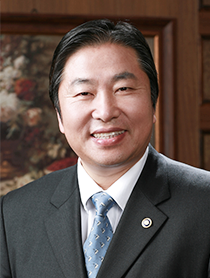Taking the Next Step to Mass Produce High-Conductive Organic Transparent Material
A research team led by Professor Jung Hyun Kim has succeeded in developing conductive polymers used in flexible, wearable devices.
Amid the growing needs for the development of devices with both electric characteristics and flexibility, ‘Organic electronic device’ is emerging as a next-generation flexible device materials. The organic electric material is conductive plastic that has the advantages of organic materials, which are light and easy to process. Among these materials, conductive high molecular materials(conducting polymer) are most widely researched and commercialized. However, the electric conductivity(the value that indicates the degree of conductivity) of the organic electronic materials researched so far is low so that it is difficult to realise high performance in the application stage.
Many research teams around the world have made significant efforts to improve the electric conductivity of conduct polymers. However, most of them have not focused on the liquid process, but on the process in which after forming the thin layer of conducting polymer, the film is dipped in a polar solvent or sulfuric acid solution or such solutions are applied on the surface. These methods have shown many limitations for the board to be used in the actual process due to defects of the thin conductive layer.
 The research team led by Professor Jung Hyun Kim (left) at the Department of Chemical and Biomolecular Engineering, Yonsei University, succeeded in manufacturing highly conducting polymers that has high transparency and low resistance by using PEDOT:PSS, a conducting polymers with liquid and film stability through the liquid purification process. Furthermore, they implemented this material into printed electronic devices, the process of which is all liquid-based.
The research team led by Professor Jung Hyun Kim (left) at the Department of Chemical and Biomolecular Engineering, Yonsei University, succeeded in manufacturing highly conducting polymers that has high transparency and low resistance by using PEDOT:PSS, a conducting polymers with liquid and film stability through the liquid purification process. Furthermore, they implemented this material into printed electronic devices, the process of which is all liquid-based.
“The liquid-based high conductive organic material manufactured in this study allows for direct patterning and continuous manufacturing process, which means mass production of flexible and transparent electrodes,” said Professor Kim on the significance of his research. “It is expected that in future this will make the manufacturing of various electronic devices like solar batteries and displays possible.”
“Currently, to overcome the limitations of the existing organic electronic materials, it is necessary to move away from simple applications of the existing materials and develop new materials that would eliminate those limitations,” Professor Kim pointed out. For this, he and his team are preparing for the next research project on the development of new high-conductive organic electronic material.
The research conducted by the team led by Professor Kim was supported by the Original Nano Material Technology Development Project of the National Research Foundation of Korea. The findings of the research were published as the top paper in 2014 by Nano Research, a world-leading research journal in material science, and as the Inside Cover Story by Advanced Materials in 2017.
Recommended Articles
Professor Jong-Hyun Ahn
Novel technique for producing high-resolution micro-LED displays
Professor Seong Chan Jun
Professor Donghyun Kim
Array of hope: Up close and personal with mitochondria in neurons